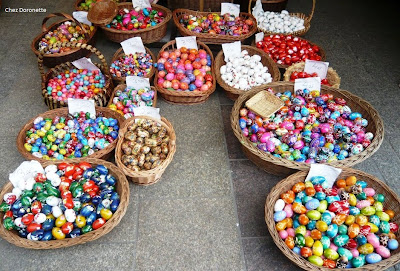Easter traditions
in Poland have a lot connections with religion. It’s the most important time
for Catholics. We celebrate Resurrection of Jesus Christ and this belief gives
us a hope for a new life.
But in fact Christ has been raised from the dead, the firstfruits of those who have fallen asleep. For as by a man came death, by a man has come also the resurrection of the dead. For as in Adam all die, so also in Christ all be made alive (1 Corinthians 15:20-22)
In fact,
preparations for this Holy Time starts on Ash Wednesday, when we go to church
to make us remember that we are dust
and to dust we shall return. It’s the first day of Lent, about 46 days before
Easter. Lent is still important in Poland. Maybe there is less and less people
who sacrifice something during this special time, but we can still meet them.
It’s not completely about religion, not only about prayers, it’s also about
trying your character.
Another
tradition is to prepare the palm branch (symbol of victory, triumph, peace and
eternal life, which commemorates the arrival of Jesus into Jerusalem) for The Sunday of the Lord's Passion. It’s joyful time. According to the old
tradition, there is a lot of contests for the most beautiful and largest palm.
The most famous is in Kurpie region. I advise you to check the link below http://www.gminalyse.pl/Palmowa2013.html
The custom of coloring eggs is still alive in Poland. The simplest way
is to cooked eggs with onion skins; you can also leave some signs on the egg
before. The most popular Easter symbols are lamb, cross, Easter greetings,
flower… In the past, by giving an Easter
egg you showed that you’re interested in someone.
And here we are, today it’s Holly Saturday. If you’re in Poland, you’ll
meet thousands of people keeping their baskets in their hands and going to the
church to bless the food. In traditional polish basket you’ll find hard-boiled eggs
(symbol of a new life), bread (Jesus), salt (purification), horseradish (bitter
sacrifice of Christ), ham and sausage (joy and abundance), fruits and cakes. All
baskets are decorated with sprigs of boxwood. After the ceremony, It’s also the time for
wishes and collecting food (products from basket) for poor people.
According to the tradition, the
blessed food needs to stay untouched until Holly Sunday breakfast. The table is covered with a white tablecloth –
symbol of the white swaddling cloth with which body of Christ was wrapped in
Holy Sepulcher. There is also a tradition to share blessed eggs and wish each
other good health. On traditional polish breakfast, you’ll also try żurek –
Easter soup, cooked by fermented rye flour with white sausage, smoked bacon,
eggs. You can add cooked potatoes or eat it with bread.
Monday after the Holly Sunday it’s called Wet Monday. It’s a pagan
custom, celebrated by everyone by sprinkling each other with cold water. Before
it was a symbol to clean soul from the sins, nowadays people believe that it
brings luck for all the year. Be careful, if you are in Poland, no mater of the weather you can be
really wet.
There is also another custom celebrated that day, you need to come to
Wieliczka, little town next to Cracow. It’s all about Siuda Baba – folk tradition.
According to the legend, the holly fire was kept by priestess during all year. Only
on the beginning of Spring time she was allowed to leave temple and to look for
a new priestess. Right now, Siuda Baba is a man, dressed like a old woman, with
black face. In one hand he keeps black cross, whip in another. He walks on the
streets and if he finds you you need to give him some coins. If not, you’ll be
all dirty…
Feel free to check it on http://www.wieliczka.eu/pl/1951/25220/Siuda_Baba_%E2%80%93_unikalna_tradycja_w_Wieliczce.html
Happy Easter Everyone! I hope this Easter fills your home with peace,
joy, love, happiness and plenty of colorful Easter eggs. I wish you also to get new
hopes and new beginnings !

.jpg)